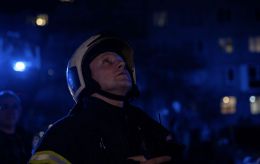'Like a nuclear explosion'. Will strike on Russia's Toropets arsenal affect frontline?
 Photo: entrances and exits were blocked due to explosions in Toropets (t.me/tvernewsru)
Photo: entrances and exits were blocked due to explosions in Toropets (t.me/tvernewsru)
Ukrainian forces have attacked a large missile and munitions depot in Toropets (Tver region, Russia). It is currently difficult to assess the full impact, but judging by the scale of the explosions and destruction, it is likely to impair the enemy's combat capabilities for at least some time.
For more details on the attack and its potential impact on the frontline, read the material by RBC-Ukraine.
Contents
- Attack on Toropets arsenal: Key facts
- What was stored at the Tver Region depots
- What Ukraine could have used to strike nearly 500 km
- How will the attack affect the frontline situation
Attack on Toropets arsenal: Key facts
The governor of Tver region, Igor Rudenya, reported a fire in Toropets at night. According to him, the fire broke out due to falling debris during the defense against a drone attack. However, he did not specify the target of the attack.
Meanwhile, videos of powerful explosions have circulated online. Russian Telegram channels report that local residents heard the distinctive sound of a drone.
Later, Tver region authorities announced an evacuation to the neighboring city of Zapadnaya Dvina. Schools and kindergartens there have been closed today. According to the Russian Ministry of Defense, 54 drones were allegedly intercepted across five regions, but neither Toropets nor Tver region were mentioned, nor were the explosions. Official information states that 13 people were hospitalized with moderate injuries.
The target was the 107th arsenal of the Main Missile and Artillery Directorate. Sources told RBC-Ukraine that Ukrainian long-range drones attacked depots containing Iskander and Tochka-U missiles, guided aerial bombs, and shells. A large fire continues to burn over an area of approximately 6 square kilometers due to the powerful detonations.
According to a source in the Defence Intelligence of Ukraine, large stocks of North Korean KN23 ballistic missiles, S-300 system, and Grad munitions were also destroyed. Over 100 strike drones were involved in the attack, covering a distance of about 500 km. The detailed consequences are still being assessed.
The incident in Toropets has become the largest non-natural fire in the Russian Federation since the start of the full-scale war. The explosions were detected by satellite, the smoke plume extended for several kilometers, and the detonations caused a minor earthquake.
In response to RBC-Ukraine’s request for a comment on the attack, Mykhailo Podolyak, advisor to the Presidential Office, described it as "very effective, impressive, but insufficient." He emphasized that the destruction of warehouse infrastructure is crucial for having an optimal impact on frontline events.
What was stored at the Tver Region depots
The arsenal in Toropets began construction in 2015, costing 3.6 billion rubles (about 60 million dollars at the 2018 exchange rate when the facility was opened). Defense Ministry officials claimed the facility met "the highest international standards," and propaganda called it a world-class facility. Its size was comparable to that of the city of Toropets itself.
According to open sources, the arsenal was designed to store 240 tons of missiles and other explosive materials. The exact amount of munitions stored there remains unknown. Serhiy Zgurets, Director of Defense Express, mentioned on a television channel that between 60 and 70 storage units, located close to each other, were destroyed, potentially holding around 30,000 tons of various munitions.
Russian Z-publics reports indirectly support his statement. They were outraged that the images of the facility were available on satellite maps from Yandex and Google. According to their data, much of the equipment in Toropets was stored outdoors. Analysts suggest that such intense explosions could have occurred if a new batch of munitions was either not yet stored or had not been removed in time.

Photo: depot in Toropets on Google maps
It is worth noting that the arsenal plays a critical role in supplying the Russian forces opposing Ukraine’s Defense Forces in the Kursk region. Therefore, the attack's impact should be viewed as a limitation on the enemy's combat capabilities.
“The ground shook, it was like a nuclear explosion... The Russians kept trying to scare Ukrainians with nuclear weapons, and Ukrainians got fed up and decided to nuke Russia,” joked Israeli military analyst Yigal Levin in a comment to RBC-Ukraine.
According to him, for Ukrainians, this is good news as none of those missiles or shells will be fired at them.
Russian anonymous Telegram channels reported the loss of 8 Kinzhal aeroballistic missiles, over 7,000 shells from North Korea, part of the missiles supplied by Iran, and the deaths of six soldiers. This information has not been officially confirmed.
What Ukraine could have used to strike nearly 500 km
Analysts from Defence Express pointed out a video where the sound of a jet engine could be heard in the background of the burning warehouses. Since the Toropets arsenal was attacked by drones, they cautiously suggest that the strikes may have involved the latest Palianytsia jet-powered drones.
These drones were first mentioned last month when President Volodymyr Zelenskyy announced their successful combat use. It was later reported that Palianytsia hit a target in temporarily occupied Ukrainian territory.
While the drone's specifications remain classified, a presentation video indicated that its range could exceed 600 km. Thus, it is quite possible that Palianytsia reached the depots in the Tver region.
.jpg)
Photo: detonation after the attack of Ukrainian drones (screenshot from the video)
Military expert and former spokesperson of the General Staff of the Ukrainian Armed Forces, Vladyslav Seleznov, is not yet ready to determine what exactly was used in the strike based on the sounds in the video.
"In any case, we will soon find out whether Ukrainian developments, such as Neptune missiles or the Palianytsia drone missile, were involved. If this is the case, it poses a very serious challenge to Russian air defense. It’s much easier for the Russians to fight when they believe we have no means to destroy their potential. But now, at least, a certain parity in the missile component might be established," he said.
Oleksandr Musiienko, head of the Center for Military-Legal Research, suggests that the arsenal in Toropets could have been attacked by a new drone missile. "But I think it wasn't just Palianytsia. This was a complex and powerful attack involving a significant number of assets, which is right because air defense was concentrated in the area and had to be bypassed. So, I don't rule out that one of the strikes may have been delivered by Palianytsia, and that's certainly good," the expert emphasized.
How will the attack affect the frontline situation
The Toropets arsenal is not just an ordinary storage facility. According to Seleznov, there are only 13 such high-level depots in Russia. He believes that the initial strike hit what was stored in the open air, and secondary detonations affected underground hangars.
"I think we will know very soon. My forecast is based on the fact that until this depot is completely detonated and burned out, it is doubtful that anyone could enter it. The destruction is too extensive, with too many ignition points," he explained.
The arsenal was primarily intended to meet the current needs of Russian forces in the Kursk and Belgorod regions, so in the near term, they may face shortages of ammunition, mortar shells, and certain types of missiles. "This is also excellent news because the Russians have not learned to fight against Ukrainian armored vehicles with just their bare hands. What happened is bound to happen again. Especially since it is not the first time that large bases and arsenals on the territory of the Russian Federation have been targeted," the expert emphasized.
According to his estimates, if 30,000 tons of ammunition, measured in mines, shells, and missiles for Grad MLRS, were destroyed, it could have supplied combat operations for six to ten months. Therefore, it’s evident that the enemy will have to restructure their logistics. Considering that the Russian military largely relies on artillery shell superiority, it's unclear how they will operate under ammunition shortages.
Today's events are unlikely to have a major impact on the tactical level, as the Russian army has enough reserves for tactical and operational operations. However, it will affect the prospects for the coming weeks. It's impossible to quickly reorganize logistics to supply the troops, particularly in the northern Kharkiv region, Seleznov added.
Oleksandr Musiienko suggests comparing it to the explosions at Ukrainian arsenals. For example, in Svatove, Balakliya, or near Ichnia and Vinnytsia between 2015 and 2018 against the backdrop of Russian aggression in Donbas.
"Let’s admit, even losing those depots did not deprive us of the ability to resist. Of course, it (Toropets attack - ed.) will weaken Russia in certain directions, reduce missile use, and delay some strikes because Russia is preparing a strike. After their foreign intelligence claimed Ukraine was allegedly planning to carry out attacks in hospitals," he said.
In his opinion, all recent attacks on Russian depots aim to prevent Russia from launching strikes, giving time for Ukraine to receive missiles and ammunition for air defense.
Such explosions inevitably affect the enemy’s combat capability. Musiienko suggests that the enemy will likely experience logistical problems in some areas, possibly in the Kursk region or elsewhere.
"This gives our units a chance to take advantage of the situation. Let me give an example from Pokrovsk. Commander-in-Chief of the Ukrainian Armed Forces, Oleksandr Syrskyi, said that the enemy was stopped in one area. Novohrodivka is the main direction of their attack. This happened because they had serious logistical problems, which couldn’t keep up with the forward Russian units. This is how it works. As soon as there are logistical issues, it immediately affects the enemy's plans. It doesn’t completely ruin them, but at least gives us an opportunity to improve our position," the expert explained.
But all this applies only to the tactical level. Speaking strategically or operationally, unfortunately, the attack on the arsenal in the Tver region will not immediately deprive the aggressor of the ability to continue waging war against Ukraine.
Sources: Russian media and Telegram channels, RBC-Ukraine's sources in the Security Service of Ukraine and military intelligence, open data, and comments from military experts Yigal Levin, Vladyslav Seleznov, and Oleksandr Musiienko for RBC-Ukraine.

